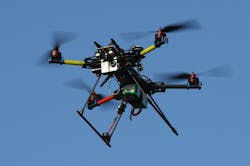Drones—small, remotely piloted aircraft—have been a prominent topic in the news for several years. Most of the stories in the United States seem to concern the military, law enforcement, or abuses by amateur pilots. In my Aug. 26, 2014, post, I wrote that we soon might have drones taking our construction-progress photos. Not surprisingly, that time is here, with several camera-ready or camera-equipped drones suitable for job-site photography selling for less than $1,000. According to recent reviews, including Tom’s Guide’s “Best Drones 2015” and MyFirstDrone.com’s “Best Drones for Sale and Why," a Chinese manufacturer—DJI—offers a well-regarded, reasonably priced copter suitable for this type of photography.
DJI’s Phantom series, for example, has models ranging in price from around $699 (designed for either the GoPro Hero3 or Hero4 Black camera) to $1,259. Other DJI models, intended for professional filmmakers, are priced as high as $4,550, with competitive copters going for more than $10,000. The $699 DJI model is ready to fly out of the box and will stay up for approximately 25 minutes on its fully charged LiPo battery. Weighing just 1,160 grams, including battery, it can climb at a rate of 6 meters per second and fly at a top speed of 15 meters per second. Photo options include 14-megapixel stills and 1080/30p or 1080/60i high-definition video recording. Recently, an architect friend/client of mine mentioned he would like to have a drone to take site and project photos, and I think that probably is the market DJI had in mind when it introduced this copter.
Before all of you architects, engineers, and contractors run out and buy a drone, there are a few things to consider. First of all, as any reader who has flown a radio-controlled (RC) plane (especially a helicopter—I know, I have one) has learned, it takes both skill and practice. Any drone suitable for job-site photography will have multiple motors/rotors (propellers) and three-axis control: pitch, roll, and yaw. My suggestion would be to buy a low-priced beginner copter—there are several for less than $100 and some for less than $50—and practice with it. When you’ve mastered its operation and moved on to your serious drone, you can give the starter model to your kids or your neighbor’s kids.
You also need to understand where you can—and cannot—fly your drone. All of us have heard the expression “no fly zone,” and we now know, if we didn’t prior to recent events, that the White House is definitely one! In fact, all of Washington, D.C., and the area within a 15-mile radius of Regan National Airport are no-drone zones. So are U.S. military bases, major airports (medium to large airports have a five-mile radius excluding drones and RC aircraft), and, not as obvious, national parks. Also, individual property owners can restrict non-government drones from flying through their “airspace,” and the Federal Aviation Administration has proposed rules that would regulate the operation of non-recreational drones weighing less than 55 pounds. These rules would limit flights to daylight hours, require visual-line-of-sight operation, impose height restrictions, require operator certification, provide for the optional use of a visual observer, require drone registration and marking, and impose operational limits.
That said, the technology is only going to improve, prices are going to come down, construction-site photography is going to continue to be necessary to our industry … and flying a drone over our job sites sounds like fun!










